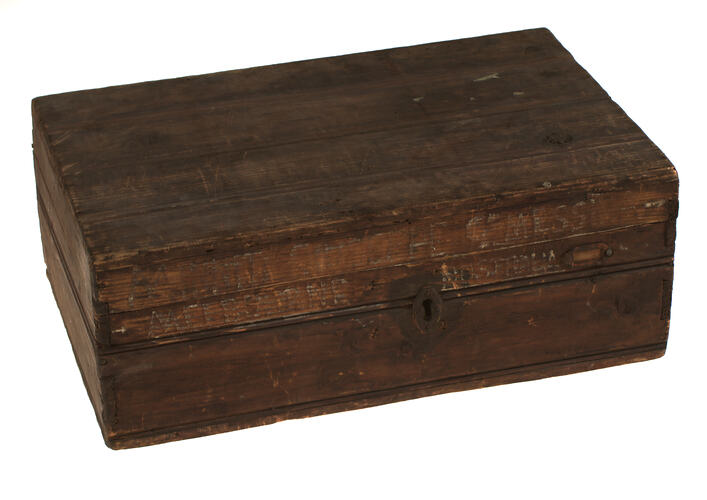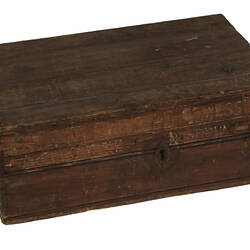Summary
Alternative Name: Suitcase
Small wooden hand made travelling case, made and used by Giuseppe Giovanni Minniti when he migrated to Melbourne from his home in Limpidi, Calabria in Italy in 1950. The case has the name, destination, departure date and place etched on the outside of the case and the inside of the lid.
Giuseppe wished to avoid national service in Yugoslavia and departed from Messina on the ship 'Sebastiano Caboto' on 23 March, travelling alone via the Suez Canal. He arrived at Victoria Dock Melbourne on 22 April 1950.
Giuseppe made the small suitcase in a hurry in order to carry items at the request of friends and relatives to take with him to people in Melbourne. He had another trunk to transport his own personal belongings. Soon after his arrival he moved to South Gippsland where he worked as a farm hand. Almost three months later, Giuseppe moved back to Melbourne and after a short stint at the Windsor Smith shoe factory in Fitzroy, he joined the Victorian Railways at Footscray Station for eight years. Giuseppe purchased a house in Footscray and rented out rooms to two other men. At this time he also had an informal barber's outlet from home where he cut hair for family, friends and neighbours. He married Giulia in 1959, moved to another house in Footscray and the couple had four children. From 1967 the couple ran a milk bar for seven years and then Giuseppe worked for Repco for the rest of his working life.
Physical Description
Wooden travelling case, dark brown in colour, with double grooves along the top and side of the case and dovetailed joints. Hand made metal hinges join the lid to the base, along with a green fabric strap. Identical nails on the other side indicate that there was another strap now missing. The case is roughly made with the inside raw timber. The front of the case has a rusted metal key hole and an empty name plate. White paint text on outside of case. Inside lid of case also has written text.
Significance
This travelling case is an iconic symbol of the migrant experience, reflecting the journey, and the modesty of the number of possessions brought. The inscriptions offer a very personalised and visual record the individual's departure point and destination. The case was originally purchsed in an opportunity shop and its historical value was substantially increased in 2012 when the family recognised their father's case on the Museum's website and contacted the Museum in order to share their family story.
More Information
-
Collecting Areas
-
Acquisition Information
Purchase
-
Maker
-
User
-
User
Giuseppe Minniti, Melbourne, Greater Melbourne, Victoria, Australia, 1950
-
Inscriptions
Front of case: MELBOURNE AUSTRALIA. Inside lid of case: MINNITI/GIUSEPPE/FU. GPPE. Inside lid of case: SOVENER/THIS CASE IS ONE OF THE TWO/ON MY ARRIVAL IN AUSTRALIA/FROM:/LIMPIDI CZ. ITALIA/23-3-1950/ARRV. MELB. VICTORIA DOCK 22-4-1950/8.30PM.
-
Classification
-
Category
-
Discipline
-
Type of item
-
overall dimensions
50 cm (Length), 32 cm (Width), 18.3 cm (Height)
-
Exhibition Collection Management
500 mm (Length), 320 mm (Width), 190 mm (Height)
-
Dimensions
320 mm (Length), 500 mm (Width), 190 mm (Height)
Measurement From Conservation. Measuring Method: measurements taken while the case was closed
-
Keywords
Brought Goods, Immigration, Italian Communities, Italian Immigration, Luggage, Migration & Settlement


